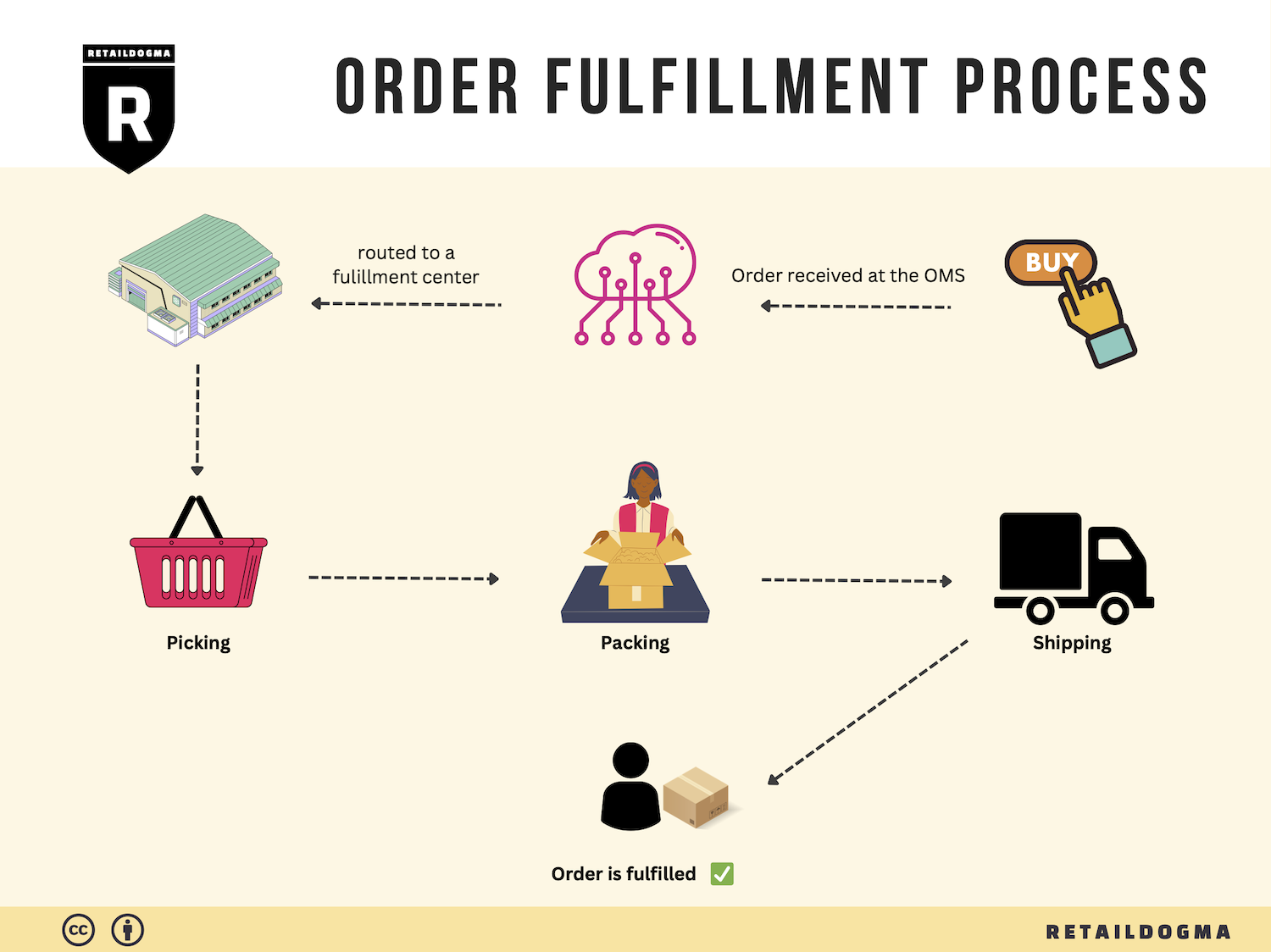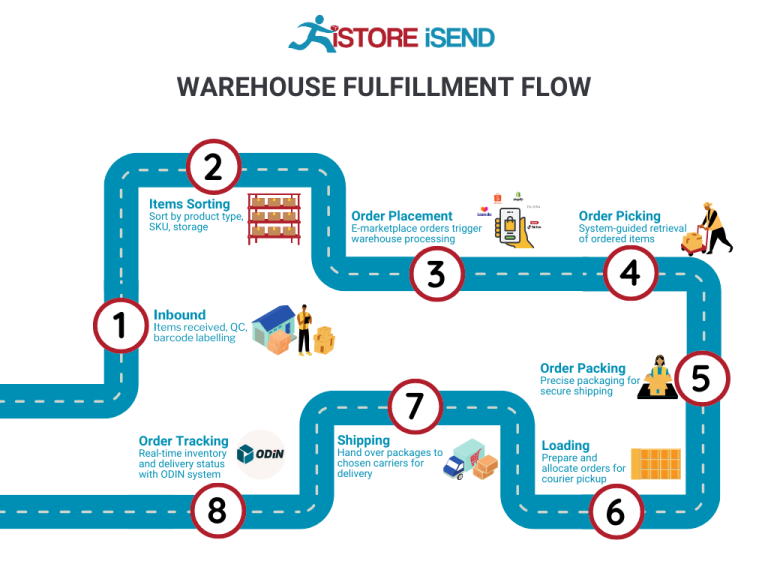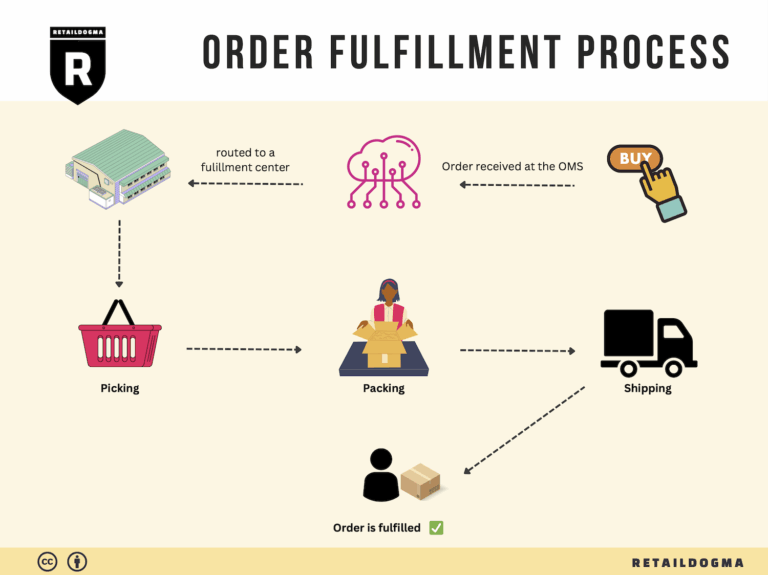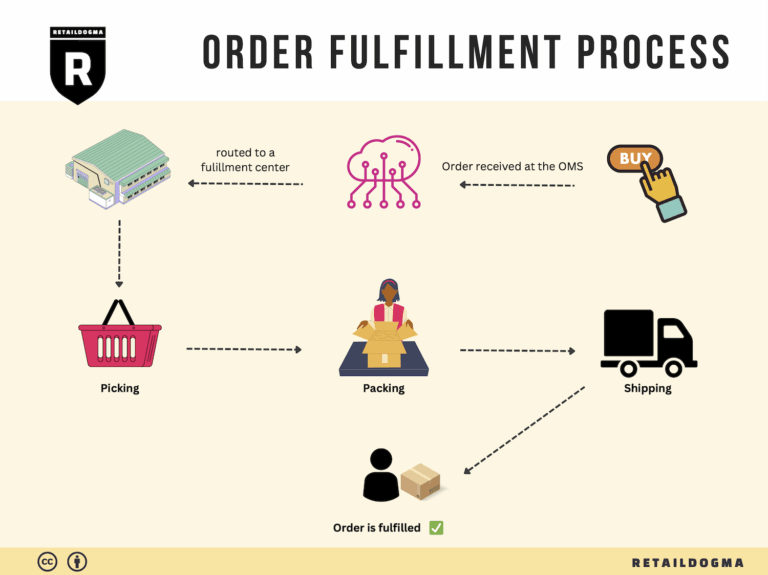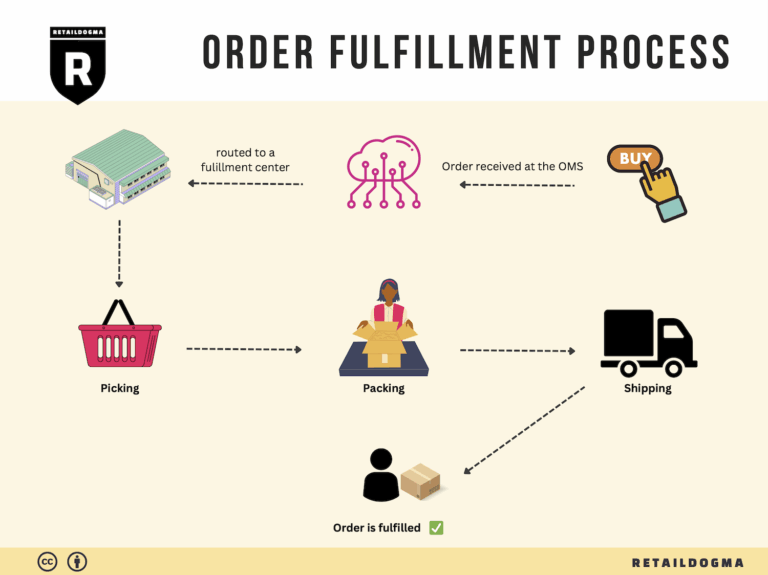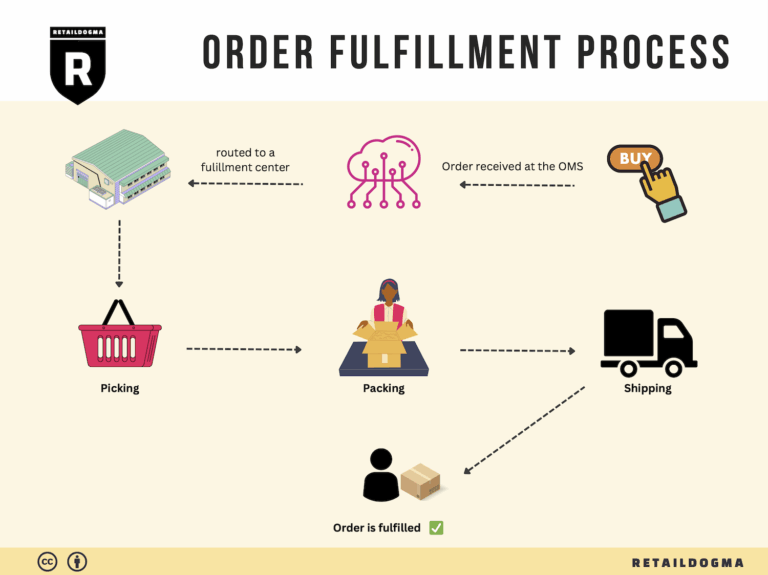How Order Fulfillment Works: A Step-by-Step Guide for Businesses
What is E-commerce Fulfillment? An Introduction for Growing Businesses
Understanding E-commerce Fulfillment: A Key to Scaling Your Business
As an e-commerce business owner, you may find yourself overwhelmed with the daily grind of packing and shipping orders. This common pain point can distract you from focusing on growth, customer engagement, and product development. E-commerce fulfillment is the critical process that bridges the gap between your products and your customers, ensuring that every order is processed efficiently and delivered promptly.
In simple terms, fulfillment encompasses all the steps involved in getting a product into the hands of a customer. This includes receiving inventory, warehousing, picking and packing orders, shipping, and handling returns. As your business grows, managing these logistics can become increasingly complex, which is why understanding the various fulfillment models available is essential.
This guide will delve into the different fulfillment models, such as Third-Party Logistics (3PL) and Fulfillment by Amazon (FBA), each offering unique advantages depending on your business needs. You’ll learn about the core services involved in e-commerce fulfillment, including inventory management, order processing, and shipping solutions.
Choosing the right fulfillment partner is another critical aspect we will explore. Factors such as location, technology integration, scalability, and service quality should all be considered to ensure that your fulfillment strategy aligns with your business goals. Additionally, we will cover pricing structures associated with various fulfillment services, helping you understand the cost implications of different partners and models.
Ultimately, the goal of this guide is to empower you with the knowledge needed to make informed decisions about your logistics strategy. By understanding the nuances of e-commerce fulfillment, you can select the right partners and solutions that will not only streamline your operations but also enhance customer satisfaction. As you navigate the complexities of scaling your e-commerce business, a solid fulfillment strategy can be your key to success, allowing you to focus on what you do best: growing your brand and serving your customers.
What You’ll Learn In This Guide
- What is E-commerce Fulfillment? An Introduction for Growing Businesses
- The Order Fulfillment Process: From ‘Buy’ Button to Customer’s Door
- Comparing Fulfillment Models: In-House vs. 3PL vs. Dropshipping
- A Deep Dive into Amazon FBA: Pros, Cons, and Who It’s For
- Core Services Offered by Fulfillment Centers
- How to Choose a Fulfillment Partner: A 6-Point Checklist
- Understanding Fulfillment Pricing: A Breakdown of Common Fees
- Frequently Asked Questions (FAQs) about Fulfillment
- Conclusion: Is Outsourcing Fulfillment the Right Move for Your Business?
- Important Disclaimer
The Order Fulfillment Process: From ‘Buy’ Button to Customer’s Door
1. Receiving Inventory
The first step in the order fulfillment process is receiving inventory, which involves the acceptance and logging of products into your warehouse. This is a critical phase where items are checked against purchase orders to ensure accuracy. Each product is assigned a Stock Keeping Unit (SKU), a unique identifier that facilitates tracking and inventory management.
Why is this important? Proper inventory receiving sets the foundation for an efficient fulfillment process. If errors occur at this stage, such as receiving the wrong quantities or damaged goods, it can lead to issues down the line, including delays in order processing and customer dissatisfaction. Efficient receiving practices also include cycle counting, which helps maintain inventory accuracy and minimizes discrepancies.
2. Warehouse Storage
Once inventory is received, the next step is warehouse storage. This involves organizing the products within the warehouse in a manner that maximizes space and enhances retrieval efficiency. Effective warehouse management systems (WMS) utilize various storage strategies, such as FIFO (First In, First Out) or LIFO (Last In, First Out), depending on the nature of the products.
Why is this important? Proper storage is crucial for maintaining inventory integrity and ensuring quick access during the picking process. A well-organized warehouse minimizes the time employees spend searching for items, ultimately speeding up order fulfillment. Additionally, using a WMS allows for real-time inventory tracking, which is vital for effective supply chain management.
3. Order Picking
Order picking is the process where items are retrieved from storage to fulfill customer orders. This step often utilizes pick lists, which are generated based on incoming orders and direct warehouse staff to the specific locations of items. Depending on the volume and complexity of orders, businesses may choose various picking methods, including single order picking, batch picking, or zone picking.
Why is this important? The accuracy and speed of order picking significantly influence customer satisfaction. Errors during picking can lead to incorrect shipments, resulting in increased return rates and dissatisfied customers. Implementing technologies such as barcode scanners or pick-to-light systems can enhance picking accuracy and efficiency, reducing the likelihood of human error.
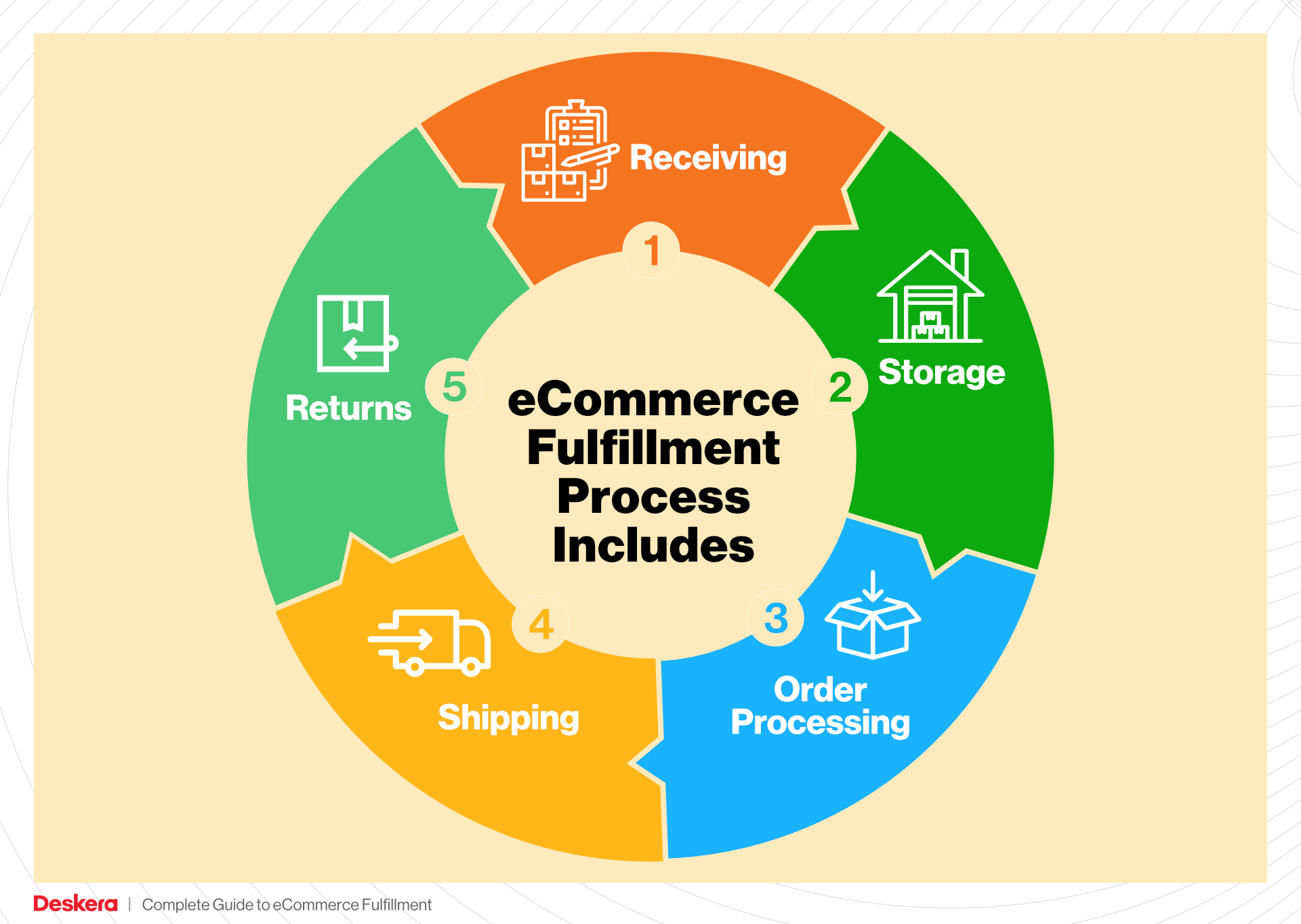
4. Order Packing
After items have been picked, they move to the packing station. This step involves carefully packing products to prevent damage during transit and to ensure that the order is complete. Packaging materials can range from simple boxes to branded packaging that reinforces the company’s identity. Key considerations during packing include weight distribution, cushioning, and compliance with shipping regulations.
Why is this important? Proper packing is essential for protecting items during shipping and ensuring that they arrive in pristine condition. Additionally, well-packaged products can enhance the customer experience, reinforcing brand loyalty. Efficient packing processes also contribute to faster shipping times, as streamlined packing can reduce bottlenecks in the fulfillment workflow.
5. Shipping & Delivery
The final step in the order fulfillment process is shipping and delivery. This involves selecting the appropriate shipping carrier and method based on factors like cost, speed, and destination. Businesses often use shipping software to compare rates and manage logistics efficiently. Once the package is shipped, tracking information is provided to customers, allowing them to monitor their orders until they arrive.
Why is this important? Shipping and delivery are critical to customer satisfaction and can greatly influence repeat business. Timely and accurate deliveries enhance the overall shopping experience, while delays or issues can lead to negative reviews and lost customers. Additionally, providing tracking information can alleviate customer anxiety about order status, contributing to a positive perception of your brand.
By mastering each step of the order fulfillment process, businesses can significantly enhance their operational efficiency, reduce costs, and improve customer satisfaction, all of which are vital for scaling successfully in the competitive e-commerce landscape.
Comparing Fulfillment Models: In-House vs. 3PL vs. Dropshipping
Fulfillment Model Comparison
| Model | Who Handles Inventory | Best For (Business Stage) | Key Advantage | Key Disadvantage |
|---|---|---|---|---|
| In-House Fulfillment | The business itself | Established businesses with stable demand | Full control over inventory and processes | High fixed costs and resource requirements |
| Third-Party Logistics (3PL) | Outsourced logistics provider | Growing businesses looking to scale | Expertise, scalability, and cost-effectiveness | Less control over the fulfillment process |
| Dropshipping | Supplier or manufacturer | Startups and low-volume sellers | Low upfront investment and risk | Lower profit margins and less control over inventory |
In-House Fulfillment
In-house fulfillment refers to a model where the e-commerce business manages its inventory, warehousing, picking, packing, and shipping operations internally. This approach is best suited for established businesses that have a stable demand for their products and the resources to maintain a fulfillment operation. The primary advantage of in-house fulfillment is the level of control it provides over inventory management and order processing. Businesses can ensure that their products are handled according to their standards, leading to potentially higher customer satisfaction and brand loyalty. However, this model comes with significant downsides, including high fixed costs associated with maintaining a warehouse, hiring staff, and investing in technology. Additionally, businesses must also manage the complexities of logistics, which can divert focus from core competencies such as product development and marketing.
Third-Party Logistics (3PL)
Third-party logistics (3PL) involves outsourcing fulfillment operations to a specialized logistics provider. This model is ideal for growing businesses that want to scale their operations without the burden of managing inventory and fulfillment logistics themselves. The key advantage of using a 3PL is the expertise and resources these providers offer. They typically have established processes, technology, and distribution networks that can improve efficiency and reduce shipping costs. Furthermore, 3PLs can quickly scale operations in response to fluctuating demand, making them a flexible solution for businesses experiencing growth. However, the main drawback of this model is the reduced control over the fulfillment process. Businesses must rely on the 3PL’s practices, which may not always align with their standards. This can lead to potential issues with order accuracy and customer satisfaction if not managed properly.
Dropshipping
Dropshipping is a fulfillment model where the retailer does not keep products in stock but instead transfers customer orders directly to a supplier or manufacturer, who then ships the products directly to the customer. This model is particularly attractive for startups and low-volume sellers, as it requires minimal upfront investment and eliminates the need for inventory management. The primary advantage of dropshipping is the low financial risk involved, as businesses do not need to invest in inventory until they have received orders. This allows for a more flexible approach to testing new products without significant financial commitment. However, dropshipping also comes with its challenges. The profit margins are often lower compared to other fulfillment models, and businesses have limited control over inventory levels and shipping processes. Additionally, reliance on suppliers can lead to issues with stock availability and shipping delays, which may negatively impact customer satisfaction.
Conclusion
Choosing the right fulfillment model is crucial for the success and scalability of an e-commerce business. Each model has its unique advantages and disadvantages, and the decision should be based on factors such as business size, growth stage, available resources, and long-term goals. Understanding these models will empower e-commerce business owners and operations managers to make informed decisions that align with their strategic objectives, ultimately enhancing their ability to meet customer demands efficiently.
A Deep Dive into Amazon FBA: Pros, Cons, and Who It’s For
Understanding Fulfillment by Amazon (FBA)
Fulfillment by Amazon (FBA) is a service provided by Amazon that allows e-commerce sellers to store their products in Amazon’s fulfillment centers. Amazon takes care of storage, packaging, shipping, and customer service for these products, enabling sellers to leverage Amazon’s extensive logistics network. This service is particularly appealing to small and medium-sized businesses looking to scale their operations without investing heavily in their own logistics capabilities.
How FBA Works
-
Setup: To get started with FBA, sellers create an Amazon seller account and enroll in the FBA program. After setting up their account, they can list products for sale and send their inventory to Amazon’s fulfillment centers.
-
Storage: Once the products arrive at Amazon’s warehouses, they are stored until sold. Sellers can monitor their inventory through the Amazon Seller Central dashboard, which provides insights on stock levels and sales.
-
Order Processing: When a customer places an order for a product fulfilled by Amazon, Amazon handles the picking, packing, and shipping. They also manage the logistics of shipping, ensuring timely delivery.
-
Customer Service and Returns: Amazon takes care of customer service inquiries related to the FBA products, including handling returns. This not only enhances the customer experience but also allows sellers to focus on growing their business.
-
Payment: After the sale, Amazon deducts the FBA fees from the sale price and transfers the remaining amount to the seller’s account. Sellers can track their sales and fees through the Seller Central interface.
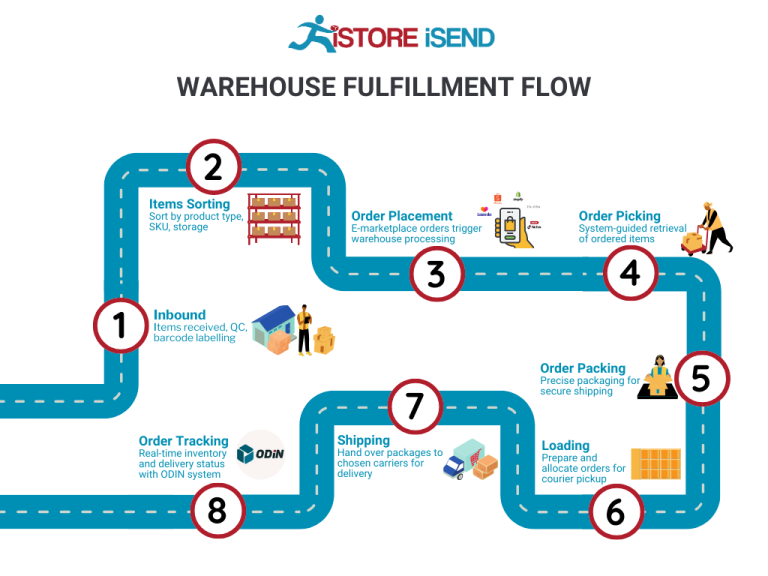
Pros of FBA
1. Prime Eligibility
One of the most significant advantages of using FBA is that products are eligible for Amazon Prime. This means that Prime members can enjoy fast, free shipping, which can significantly increase sales. As of recent data, Prime members have been shown to spend more than non-Prime members, making this eligibility a powerful selling point.
2. Customer Trust
Amazon is a well-established and trusted platform. By using FBA, sellers can benefit from Amazon’s reputation, which can enhance customer trust in their products. Customers are more likely to purchase from sellers whose products are fulfilled by Amazon due to the promise of reliable shipping and customer service.
3. Multi-Channel Fulfillment
FBA isn’t limited to Amazon’s marketplace. Sellers can use FBA to fulfill orders from other sales channels, including their own websites or other e-commerce platforms. This flexibility allows businesses to streamline their logistics and offer consistent shipping experiences across multiple platforms.
4. Streamlined Logistics
With FBA, sellers can delegate logistics to Amazon, freeing up time and resources to focus on other aspects of their business, such as product development and marketing. Amazon’s vast logistics network ensures efficient handling of inventory and order fulfillment.
5. Advanced Inventory Management
Amazon provides tools for inventory management, including real-time tracking and reporting capabilities. Sellers can access data on their inventory levels, sales trends, and performance metrics, which can inform better decision-making.

Cons of FBA
1. High Fees
While FBA offers many benefits, it comes with a cost. Sellers must pay various fees, including storage fees for inventory held in Amazon warehouses and fulfillment fees for each unit sold. These costs can add up quickly, particularly for sellers with lower-priced items or high inventory turnover.
2. Strict Inventory Rules
Amazon has stringent guidelines regarding inventory management. Sellers must adhere to specific packaging requirements, labeling rules, and inventory limits. Failure to comply can lead to additional fees or even account suspension, which can be detrimental to a seller’s business.
3. Commingling Risks
FBA operates on a commingling model, where inventory from multiple sellers can be stored together. This can lead to issues if a seller receives returns or negative reviews related to another seller’s product. Sellers may find it difficult to maintain brand integrity and quality control under this model.
4. Limited Control
By outsourcing fulfillment to Amazon, sellers relinquish some control over the fulfillment process. This includes aspects like branding, packaging, and customer interaction. For some businesses, this loss of control can be a significant drawback.
5. Inventory Management Challenges
While Amazon provides tools for inventory tracking, managing inventory levels across multiple fulfillment centers can be challenging. Sellers must remain vigilant to avoid stockouts or excess inventory, both of which can incur additional costs.
Who is FBA Best For?
FBA is ideally suited for:
-
Small to Medium-Sized Businesses: Those looking to scale quickly without the burden of managing logistics can benefit significantly from FBA.
-
E-commerce Entrepreneurs: Individuals or businesses with limited resources for warehousing and fulfillment who want to reach a wider audience through Amazon’s platform.
-
Brands Seeking Trust and Visibility: Companies that want to leverage Amazon’s brand recognition and customer trust while focusing on product development and marketing.
-
Multi-Channel Sellers: Businesses selling across multiple platforms that wish to streamline their fulfillment processes through Amazon’s efficient logistics network.
In conclusion, while FBA presents numerous advantages, particularly in terms of logistics and customer trust, it also comes with its own set of challenges. Sellers should carefully evaluate their business model, product types, and long-term goals to determine if FBA aligns with their operational strategy.
Core Services Offered by Fulfillment Centers
Inventory Management & Warehousing
Effective inventory management and warehousing are foundational elements of any successful e-commerce operation. Fulfillment centers provide businesses with dedicated space to store products, ensuring that inventory is organized, secure, and easily accessible. This service includes receiving shipments, logging products into inventory systems, and maintaining optimal stock levels through regular cycle counts.
Benefits:
1. Efficiency in Stock Handling: Fulfillment centers utilize advanced inventory management systems that track stock levels in real-time. This reduces the risk of stockouts or overstock situations, enabling e-commerce businesses to operate smoothly and meet customer demand without interruption.
-
Cost Savings: By outsourcing warehousing, businesses can eliminate the overhead costs associated with maintaining their own storage facilities, such as rent, utilities, and staffing. This allows for better allocation of resources towards growth and innovation.
-
Strategic Location: Many fulfillment centers are strategically located near major shipping routes and urban centers, which can significantly reduce shipping times and costs. This geographical advantage enables faster delivery to customers, enhancing their shopping experience and increasing the likelihood of repeat business.
Pick and Pack Services
Pick and pack services are essential for fulfilling orders accurately and efficiently. Once an order is placed, fulfillment centers employ a systematic process to pick the items from the warehouse, pack them securely, and prepare them for shipment. This process often involves the use of technology, such as barcode scanning, to ensure that the correct items are selected.
Benefits:
1. Accuracy and Speed: Automated picking systems and trained staff help ensure that orders are filled accurately and swiftly. High accuracy in order fulfillment reduces the likelihood of returns and enhances customer satisfaction.
-
Scalability: As e-commerce businesses grow, their order volumes can fluctuate significantly. Fulfillment centers are equipped to handle varying volumes, whether it’s a surge during peak seasons or steady daily orders, allowing businesses to scale operations without investing in additional labor or infrastructure.
-
Custom Packaging Options: Many fulfillment centers offer custom packing solutions, including branded packaging, which can help enhance brand identity and improve the unboxing experience for customers. This attention to detail can differentiate a business in a competitive market.
Kitting and Assembly
Kitting and assembly services involve the grouping of individual items into a single package or kit that can be sold as a unit. This service is particularly beneficial for businesses that offer bundles, promotional kits, or complex products that require assembly before shipping.
Benefits:
1. Enhanced Product Offerings: By providing kitting services, fulfillment centers enable e-commerce businesses to offer bundled products, which can increase average order value and attract more customers looking for convenience.
-
Time Efficiency: Outsourcing kitting and assembly allows businesses to focus on their core competencies, such as product development and marketing, while leaving the logistical complexities to the fulfillment center. This efficiency can lead to faster product launches and a more agile response to market demands.
-
Quality Control: Fulfillment centers often implement strict quality control measures during the kitting process, ensuring that all items are assembled correctly and meet quality standards before reaching the customer. This minimizes the risk of customer dissatisfaction and returns.
Returns Management (Reverse Logistics)
Returns management, or reverse logistics, is a critical component of the e-commerce fulfillment process. It involves handling returned items efficiently, from processing returns to restocking or disposing of items. A well-managed returns process can significantly impact customer satisfaction and loyalty.
Benefits:
1. Customer Retention: A streamlined returns process improves the overall customer experience. Easy returns can lead to higher customer satisfaction and loyalty, as shoppers are more likely to return to a retailer that handles returns gracefully and efficiently.
-
Data Insights: Fulfillment centers can provide valuable insights into return reasons and patterns, which can inform product development and marketing strategies. Understanding why customers return products can help businesses make improvements and reduce future returns.
-
Cost Management: Effective returns management can minimize losses associated with returns. Fulfillment centers often have systems in place to assess returned products quickly, determine their condition, and decide whether to restock, refurbish, or recycle, thus optimizing inventory and reducing waste.
In conclusion, partnering with a fulfillment center can provide e-commerce businesses with a competitive edge by streamlining operations, enhancing customer satisfaction, and allowing for scalable growth. By leveraging services like inventory management, pick and pack, kitting, and returns management, businesses can focus on their core mission while ensuring efficient and effective order fulfillment.
How to Choose a Fulfillment Partner: A 6-Point Checklist
Location & Warehouse Network
When choosing a fulfillment partner, the location and distribution of their warehouses are crucial. A strategically placed warehouse network can significantly impact shipping times and costs, which are essential for customer satisfaction and retention.
- Why It Matters: Proximity to your customer base can reduce shipping times, lower transportation costs, and improve your overall delivery service.
- Questions to Ask:
- How many warehouses do you operate, and where are they located?
- Can you provide a map of your warehouse network?
- How do you determine which warehouse will fulfill a particular order?
- Are your warehouses equipped to handle different types of products?
Technology & Integrations
In today’s digital world, a fulfillment partner’s technology capabilities are pivotal. Your fulfillment partner should provide robust systems that integrate seamlessly with your e-commerce platform, inventory management systems, and other operational tools.
- Why It Matters: Advanced technology can streamline your operations, reduce errors, and provide real-time visibility into your inventory and order status.
- Questions to Ask:
- What technology platforms do you use for order management and fulfillment?
- Can your system integrate with major e-commerce platforms (like Shopify, WooCommerce, etc.)?
- Do you provide real-time tracking for both inventory and shipments?
- How do you handle data security and compliance with industry regulations?
Specializations (e.g., cold storage, oversized items)
Different businesses have different needs. If your products require special handling, such as temperature control for perishables or specific packaging for oversized items, finding a fulfillment partner with the right expertise is vital.
- Why It Matters: Specialized services can ensure that your products are stored and shipped correctly, maintaining quality and compliance with regulations.
- Questions to Ask:
- What types of special handling or storage do you offer?
- Do you have experience handling products similar to mine?
- What certifications do your facilities have for specialized storage (e.g., FDA approval for food storage)?
- Can you accommodate seasonal fluctuations in product demand?
Scalability & Capacity
Your fulfillment partner should be able to grow with your business. Whether you’re planning to expand your product line, enter new markets, or handle seasonal spikes in demand, scalability is essential.
- Why It Matters: A partner with flexible capacity can help you avoid fulfillment bottlenecks and support your growth without significant disruptions.
- Questions to Ask:
- How do you manage seasonal fluctuations in order volume?
- What processes do you have in place for scaling up operations?
- Can you provide case studies or examples of how you’ve supported other clients’ growth?
- What is the maximum volume you can handle, and how quickly can you scale operations?
Pricing and Contracts
Understanding the pricing structure and contract terms is fundamental to ensuring that your fulfillment partnership is financially viable. Look for transparency and flexibility in pricing to avoid unexpected costs.
- Why It Matters: Hidden fees or rigid contract terms can strain your budget and limit your operational flexibility.
- Questions to Ask:
- Can you provide a detailed breakdown of your pricing structure?
- Are there any hidden fees (e.g., for storage, returns, or handling)?
- What are the terms of your contracts, and is there flexibility for adjustments as my business grows?
- How do you handle pricing for international shipping or specific service requests?
Customer Support & Reviews
The level of customer support you receive can make or break your fulfillment experience. A partner that offers responsive and knowledgeable support can help resolve issues quickly and maintain your operational efficiency.
- Why It Matters: Good customer support ensures that you have someone to turn to for assistance, which is crucial during peak seasons or when unexpected challenges arise.
- Questions to Ask:
- What customer support options do you offer (e.g., phone, email, chat)?
- What are your typical response times for support inquiries?
- Can you provide references or testimonials from current or past clients?
- How do you handle disputes or issues that arise during the fulfillment process?
By carefully evaluating potential fulfillment partners against these six key areas, you can make an informed decision that aligns with your business needs and growth aspirations. A well-chosen partner not only enhances your operational efficiency but also contributes to a positive customer experience, ultimately supporting your e-commerce success.
Understanding Fulfillment Pricing: A Breakdown of Common Fees
Initial Setup Fees
When partnering with a fulfillment provider, the first financial consideration is often the initial setup fee. This charge typically covers the administrative costs associated with onboarding your business, which may include account creation, system integration, and training on the fulfillment platform. Depending on the provider, setup fees can vary significantly, ranging from a few hundred to several thousand dollars.
How It’s Calculated:
The fee is usually a flat rate but may also be influenced by the complexity of your operations. For example, if your business requires extensive customization or integration with multiple sales channels, the setup fee might be higher. It’s crucial to inquire about what specific services are included in this fee to avoid unexpected charges down the line.
Receiving Fees
Receiving fees are incurred when your inventory arrives at the fulfillment center. This charge covers the labor and resources needed to unload, inspect, and store your products. Receiving fees can vary based on the volume and type of goods being processed.
How It’s Calculated:
Typically, receiving fees are calculated per shipment or per unit, depending on the provider’s pricing structure. Some companies may charge a flat fee for each shipment, while others might assess a fee based on the total number of items received. It’s essential to ask about any additional costs that may arise from handling specialized items, such as fragile goods.
Storage Fees (per pallet/bin)
Storage fees are charged for the space your inventory occupies within the fulfillment center. This fee can be crucial for managing your overall logistics costs, especially if you have a large inventory or are operating in a high-demand season.
How It’s Calculated:
Storage fees are generally calculated on a monthly basis and can be charged per pallet, bin, or cubic foot. The specific rate may vary based on the provider and the geographical location of their warehouses. Additionally, some fulfillment centers may implement tiered pricing, where the cost per unit decreases as the volume of stored inventory increases. Understanding the storage fee structure is vital, as long-term storage can add up quickly, particularly for slow-moving items.
Pick & Pack Fees (per item/order)
Pick and pack fees are among the most common charges in the fulfillment process. These fees cover the costs associated with selecting items from inventory (picking) and preparing them for shipment (packing).
How It’s Calculated:
Pick and pack fees can be structured in several ways: per order, per item, or a combination of both. For example, a provider may charge a flat fee for each order processed, plus an additional fee for each item picked. This can vary based on the complexity of the order (e.g., whether it involves multiple SKUs) and the packaging requirements. Businesses with a high volume of small orders may benefit from negotiating bulk rates or flat-rate pricing for predictable costs.
Shipping Fees
Shipping fees cover the costs associated with transporting your products to customers. This fee can vary significantly based on several factors, including the shipping method (standard vs. expedited), destination, package weight, and dimensions.
How It’s Calculated:
Shipping fees are often calculated based on carrier rates, which can vary depending on the shipping provider (e.g., UPS, FedEx, USPS). Many fulfillment centers offer discounted shipping rates due to their volume, which can benefit businesses looking to reduce costs. Additionally, some providers may charge handling fees for preparing packages for shipment. To manage shipping costs effectively, it’s wise to analyze the various shipping options and consult with your fulfillment partner about the best strategies for your business.
Tips for Getting an Accurate Quote
To obtain an accurate quote from a fulfillment provider, consider the following tips:
-
Provide Detailed Information: Clearly outline your business needs, including your average order volume, types of products, and any special handling requirements.
-
Request Itemized Pricing: Ask for a breakdown of all potential fees, including setup, receiving, storage, pick and pack, and shipping. This will help you understand the full scope of costs involved.
-
Compare Multiple Providers: Don’t settle for the first quote. Compare multiple fulfillment providers to find one that offers the best combination of services and pricing.
-
Inquire About Discounts: Many providers offer discounts for higher volumes or long-term contracts. Be sure to ask about any available savings.
-
Understand Terms and Conditions: Review the terms and conditions thoroughly to avoid hidden fees that could impact your overall costs.
By taking these steps, you can secure a fulfillment solution that aligns with your business goals while keeping your costs manageable.
Frequently Asked Questions (FAQs) about Fulfillment
1. What are fulfillment services?
Fulfillment services encompass the processes involved in receiving, warehousing, picking, packing, and shipping products to customers on behalf of e-commerce businesses. These services enable businesses to streamline their logistics and focus on core operations while ensuring timely delivery to their customers.
2. What is the difference between a warehouse and a fulfillment center?
A warehouse is primarily used for storing goods for long periods, often without a focus on immediate shipping. In contrast, a fulfillment center is designed specifically for the rapid processing of orders. Fulfillment centers are equipped with systems and processes that allow for quick picking, packing, and shipping of products, often utilizing advanced technology for efficiency.
3. How much do fulfillment services cost?
The cost of fulfillment services can vary significantly based on several factors, including the volume of orders, the complexity of the products, storage space requirements, and additional services like returns management. Generally, costs may range from a few dollars per order to more significant fees depending on the service provider and your specific needs. It’s advisable to request quotes from multiple fulfillment partners to compare services and pricing.
4. What is a 3PL?
A 3PL, or third-party logistics provider, is a company that offers outsourced logistics services, including fulfillment, warehousing, and transportation. By partnering with a 3PL, e-commerce businesses can leverage their expertise, technology, and networks to improve efficiency and scale operations without the need for significant capital investment in logistics infrastructure.
5. How do I choose the right fulfillment service provider?
When selecting a fulfillment service provider, consider factors such as their location, technology integration capabilities, customer service, and experience with your specific industry. Additionally, evaluate their shipping options, return policies, and any value-added services they offer, such as branded packaging or inventory management.
6. Can fulfillment services handle international shipping?
Yes, many fulfillment service providers offer international shipping solutions. They can help businesses navigate customs regulations, tariffs, and international logistics challenges. It’s essential to discuss your specific needs with potential providers to ensure they can accommodate your international shipping requirements.
7. How do fulfillment centers manage inventory?
Fulfillment centers utilize inventory management systems that track stock levels in real-time. They perform regular inventory audits and cycle counts to ensure accuracy and prevent stockouts or overstock situations. This technology allows businesses to maintain optimal inventory levels and make data-driven decisions.
8. What are the benefits of using a fulfillment service?
Using a fulfillment service can provide numerous benefits, including faster order processing, reduced shipping costs, improved customer satisfaction through timely deliveries, and scalability as your business grows. Additionally, it allows businesses to focus on marketing and product development rather than logistics.
9. What technology do fulfillment centers use?
Fulfillment centers typically use advanced technologies such as Warehouse Management Systems (WMS), automated picking systems, and real-time tracking software. These technologies enhance efficiency, accuracy, and visibility in the fulfillment process, allowing businesses to manage their operations more effectively.
10. What should I look for in terms of customer support from a fulfillment service?
When evaluating customer support from a fulfillment service, look for responsiveness, availability (24/7 support is ideal), and multiple communication channels (phone, email, chat). Additionally, assess their willingness to provide insights and reporting on order statuses, inventory levels, and performance metrics, which are crucial for informed decision-making.
Conclusion: Is Outsourcing Fulfillment the Right Move for Your Business?
The Case for Outsourcing Fulfillment
Outsourcing fulfillment can be a game-changer for e-commerce businesses aiming to scale efficiently and effectively. By partnering with a specialized fulfillment service, you can save valuable time, allowing you to focus on what truly matters: growing your brand and enhancing customer satisfaction. Fulfillment services streamline the logistics process, handling everything from inventory management to shipping and returns, which can significantly reduce operational burdens.
Scalability is another significant advantage of using a fulfillment partner. As your business grows, so do your order volumes and logistical complexities. A competent fulfillment service can adapt to your changing needs, ensuring that you can handle seasonal spikes or rapid growth without compromising service quality. This flexibility enables you to scale quickly without the need for substantial investments in warehousing and staffing.
Moreover, expertise is a critical factor. Fulfillment providers bring years of experience and advanced technologies to the table, ensuring that your operations run smoothly and efficiently. They understand the nuances of logistics, compliance, and customer expectations, which can help you avoid costly mistakes and enhance your overall service offering.
However, the success of outsourcing fulfillment hinges on choosing the right partner. Not all fulfillment services are created equal; therefore, it’s crucial to conduct thorough research and select one that aligns with your business needs and growth objectives.
As a strategic next step, consider auditing your current shipping process. Analyze your pain points, order volumes, and customer feedback. This evaluation will help you determine if partnering with a fulfillment service is the right move for your business. Taking this proactive approach can set you on the path to operational excellence and sustainable growth.
Important Disclaimer
⚠️ Important Disclaimer
The information in this guide is for educational purposes. Fulfillment services, pricing, and platform features change frequently. Always conduct your own due diligence and consult with providers directly before making business decisions.
